Major Construction at the Sohae Rocket Test Site
Summary
New commercial satellite imagery indicates that North Korea has embarked on a major construction program at the Sohae Satellite Launching Station (commonly referred to at “Tongchang-ri”), mounting six important new projects at the site since mid-2013. This activity, along with Pyongyang’s abrupt halt of a program to modernize its older Tonghae launch facility in late 2012, suggests that Sohae will remain Pyongyang’s main long-range rocket test center in the future.
Of particular interest is a construction site 100 meters west of the existing launch pad on level ground. Aligned on the same azimuth as the existing pad that would enable southward launches like the two previous Unha rocket launches, the area is about 65 meters long and 40 meters wide at the west end where the foundation for an end wall is visible. It is much smaller than the existing launch pad that measures 56 meters wide and 190 meters long.
While it is too early to identify the exact purpose of this site, one possible explanation is that Pyongyang is building a “flat launch pad,” a large concrete area that would be used to test mobile ballistic missiles fired from a transporter-erecter launcher (TEL).[1] Alternatively, a modified version of the KN-08 long-range mobile missile could launch small satellites from the pad although this would probably require a more complex arrangement with a permanent gantry tower and flame trench.
Analysis of future imagery will help determine the purpose of this new site. Circumstantial evidence, however, reinforces the launch pad hypothesis. Rockets fired from this location on an azimuth of 175 degrees could travel over 4,000 kilometers before encountering a foreign land mass. This would allow full tests of North Korea’s Musudan rocket (suspected to have a range of over 3,000 kilometers) and the KN-08 missile to nearly its estimated full range. The proximity of the new construction to the existing launch pad and its support infrastructure is also interesting to note.
Because of construction at Sohae’s key facilities as well the lack of activity at the Tonghae center, it is unlikely that North Korea will test fire an Unha or other space launch vehicles over the next six months.
Overview of Construction Activities
Recent satellite imagery indicates that North Korea has begun six new construction projects at the Sohae Satellite Launching Station since mid-2013. These projects are: 1) a construction site near the existing launch pad that may be a new launch pad; 2) construction on the existing pad used to test the Unha space launch vehicle; 3) a new bypass road adjacent to the existing pad; 4) restart of construction of a permanent radar tracking station; 5) additions to the mobile instrumentation site; and; 6) the rebuilding of a compound for the troops involved in construction projects.
Figure 1. Overview of new Sohae construction projects.
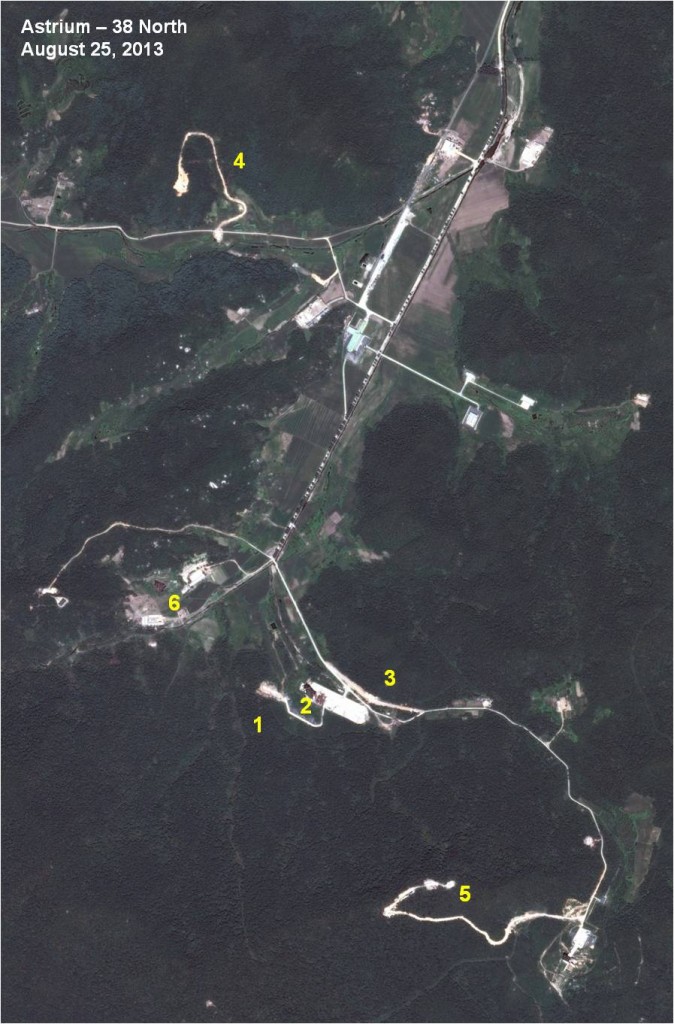
Unidentified Construction Site: Is Pyongyang Building a New Launch Pad?
Commercial satellite imagery from August 25, 2013 indicates significant construction activity—three new projects—in the immediate area of the existing launch pad that was used for previous tests of the Unha-3 space launch vehicle (SLV).[2] Of particular interest is construction of a facility 100 meters west of the existing pad on level ground. Aligned on the same azimuth that would enable southward launches—like the two previous Unha-3 SLV tests—the area is about 65 meters long and 40 meters wide at the west end where the foundation for an end wall is visible. It is much smaller than the existing launch pad that measures 56 meters wide and 190 meters long. Entry to this area is via a new road between the two smaller propellant storage buildings.
Figure 2. New construction activities at the Sohae launch pad area.
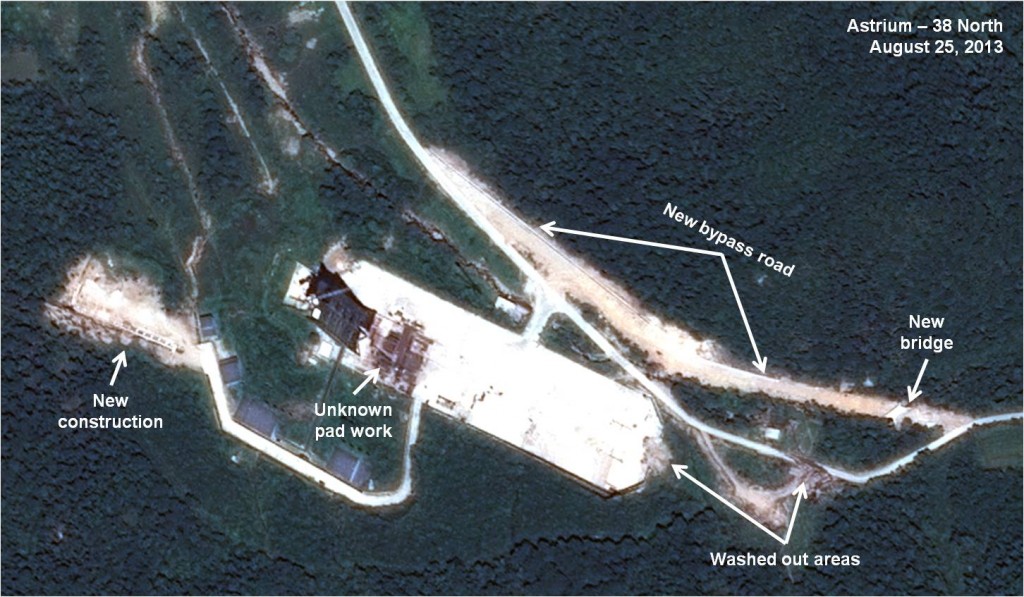
Figure 3. Unidentified facility.
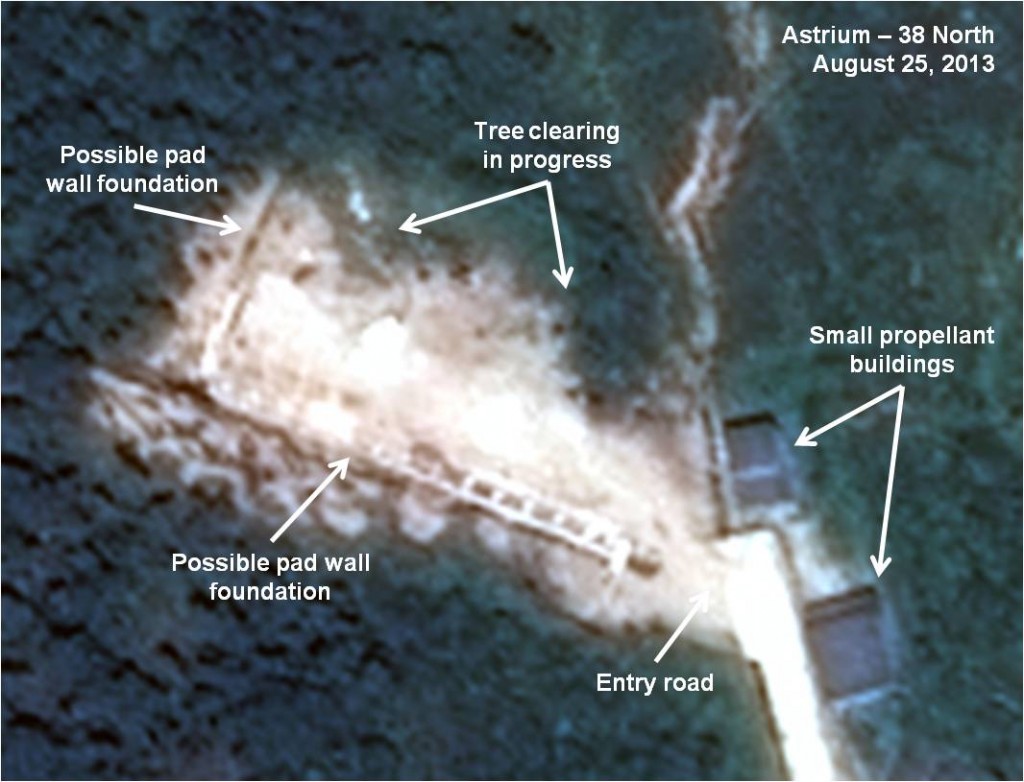
It is too soon to determine the exact purpose of the facility at this early stage of construction. There are a number of possible explanations. One is that Pyongyang is building a “flat launch pad,” a large concrete pad with possibly a small umbilical tower that has been used in the past to test mobile missiles such as Scuds and Nodongs fired from a transporter-erector-launcher (TEL) (figure 4). Another possibility is that the pad would be used to launch a modified version of the KN-08 long-range mobile missile as an SLV for small satellites. This would probably require a more complex pad arrangement with a permanent gantry tower and flame trench.
Figure 4. Flat pad previously used at North Korea’s Tonghae test site.
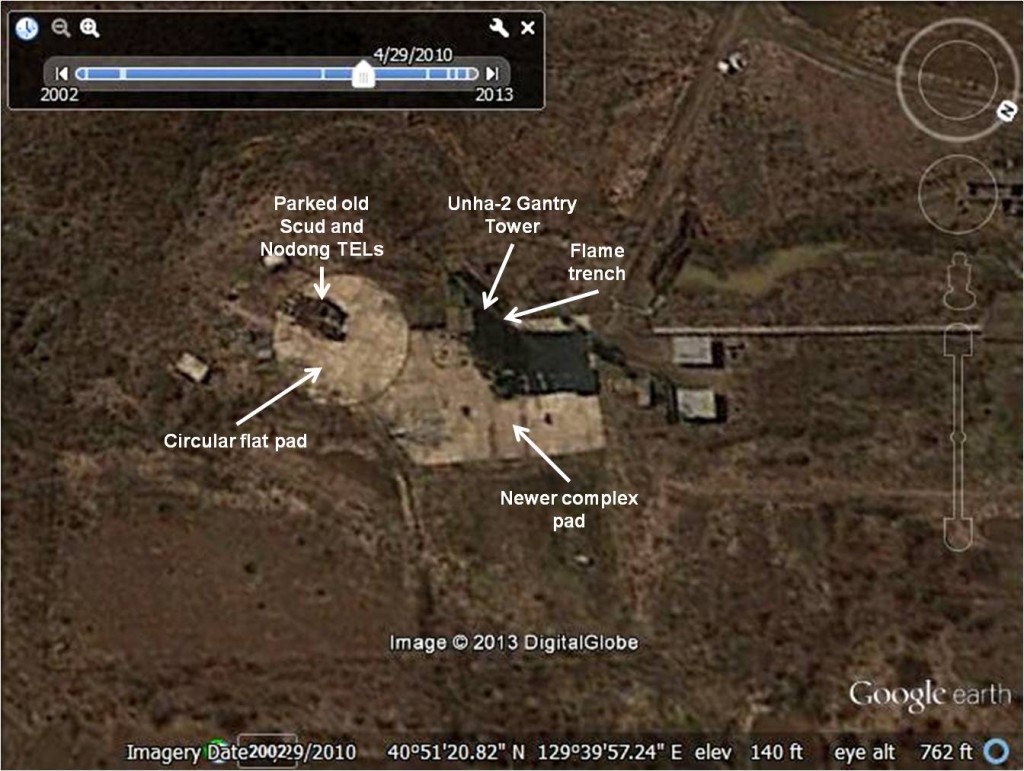
Analysis of future imagery will help determine if North Korea is building a second pad and if it is, what type of rockets the pad is intended to launch. (One key indicator will be whether a flame trench, used to direct the exhaust gas away from the rocket at launch, is excavated at the site.) Circumstantial evidence, however, supports the launch pad hypothesis. Rockets launched from this location on an azimuth of 175 degrees could travel over 4,000 kilometers before encountering a foreign land mass. This would allow full tests of North Korea’s medium-range Musudan rocket and the KN-08 missile to nearly its estimated full range.[3] The proximity of the new construction to the existing launch pad and its support infrastructure is also interesting to note.
Since it is too soon to credibly identify the purpose of this construction project, other possibilities should be considered. One alternative is that the area is for some sort of support buildings, including fuel tanks, for the existing launch pad and gantry. However, due to its close proximity to the pad, there would run a danger of causing catastrophic explosion on or near the pad during a launch.
Another project involves construction on the original launch pad close to the base of the gantry tower that extends out some 25 meters. The purpose of this work is unclear but a stack of construction material is visible on the pad. This may be related to repairs to the launch pad and its facilities, although no damage has been evident in previous satellite images, or for the other construction projects nearby. Until this material is cleared from the pad, no rocket launches can take place.
A third project is the construction of a new bypass road, probably to eliminate flooding, mudslides and washouts that have plagued the existing road serving the pad and several other facilities, including the rocket engine test stand to the southeast.[4] Much of the new road—about 300 meters—and a bridge are nearly finished and a stream is being rerouted.
New Activity at Location of Probable New Radar Tracking Station
North Korea is also building what appears to be a new radar tracking station on a nearby hill.[5] Construction originally began in 2005 on a pair of buildings that resembled the radar tracking and command destruct buildings at the older Tonghae launch site. North Korea stopped work on this new site the following year, leaving vegetation to overgrow the foundations. Imagery from August 25 indicates that the road has been improved and construction equipment has been brought in, presumably to resume work.
Figure 5. Construction at the radar tracking area.
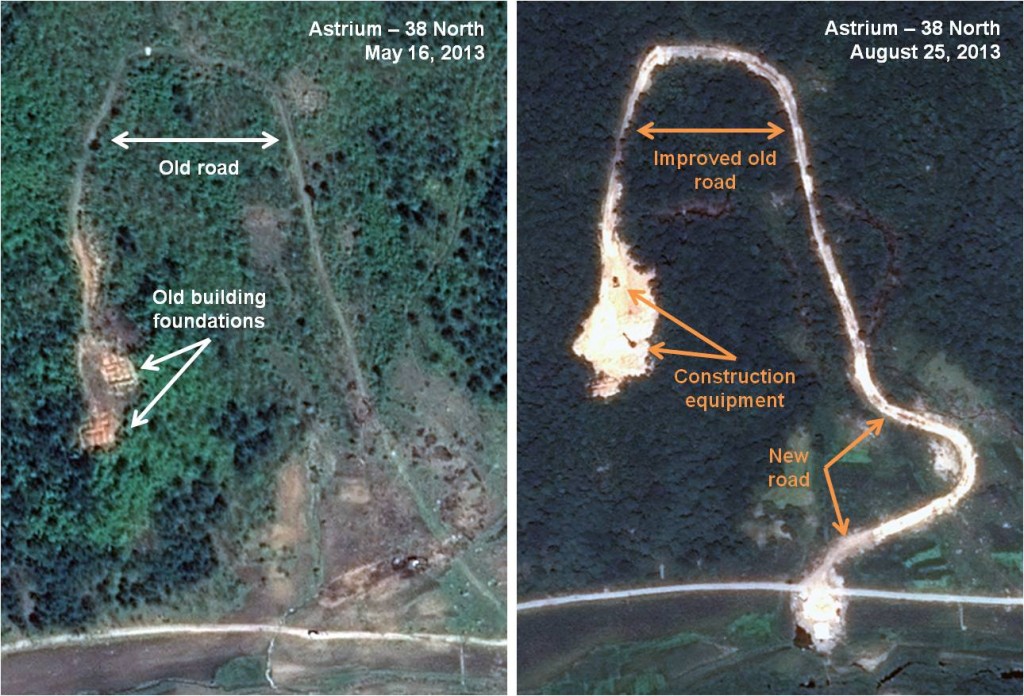
Expansion of Mobile Instrumentation Site
North Korea is also constructing new buildings at a location previously used to park mobile instrumentation trailers. These trailers provided the telemetry and tracking functions seen in the launch control center and relayed in real time to the General Satellite Control Center (GSCC) outside of Pyongyang. Trailers and equipment were moved to the site during the April and December 2012 satellite launches and were removed afterwards. The parking area has been expanded and construction of a new building completed, possibly providing permanent support for tracking and telemetry operations on site.
Figure 6. Expansion of the mobile instrumentation site.

Train at the Sohae Siding
New construction activities require workers (in this case construction troops), equipment and materials. Imagery from August 25 shows an eleven-car train parked on the inactive siding track, allowing additional trains to arrive at the station. The parked train includes an engine and ten flatbed cars normally used to transport dry cargo and vehicles. On the siding are a variety of vehicles and construction materials (figure 7). Activity has also increased at the rail station immediately north of this siding.
Figure 7. Parked freight train at Sohae siding.
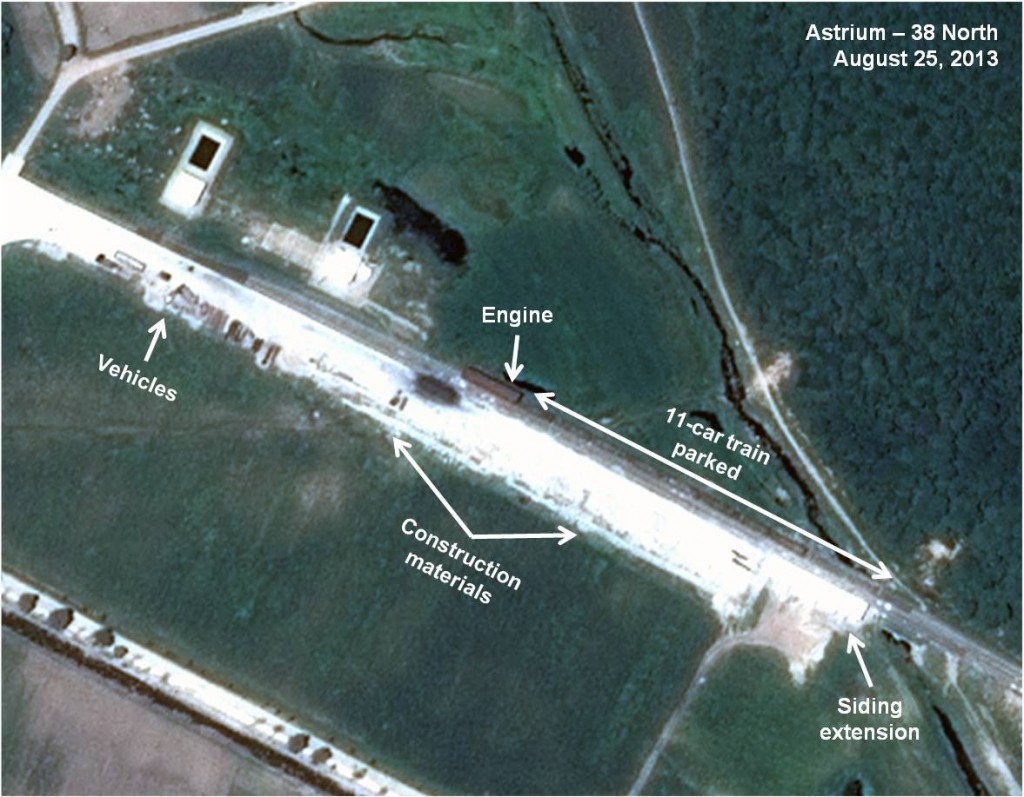
Rebuilt Military Construction Troops Compound
Construction troops engaged in the new building projects appear to be living in recently completed barracks. After work was finished at Sohae in 2011, three housing compounds were razed in the months before the first Unha-3 launch in April 2012. North Korea has now reconstructed one of the housing compounds along with six new probable warehouse buildings in a previously undeveloped area (figure 8). The rapid building of these facilities and the increased activity at the site indicates that construction at Sohae has been assigned high priority. These facilities also appear to be permanent, suggesting that North Korea is making a long-term commitment to the expansion of the Sohae launch facility.
Figure 8. Rebuilt military compound at Sohae for the construction troops.
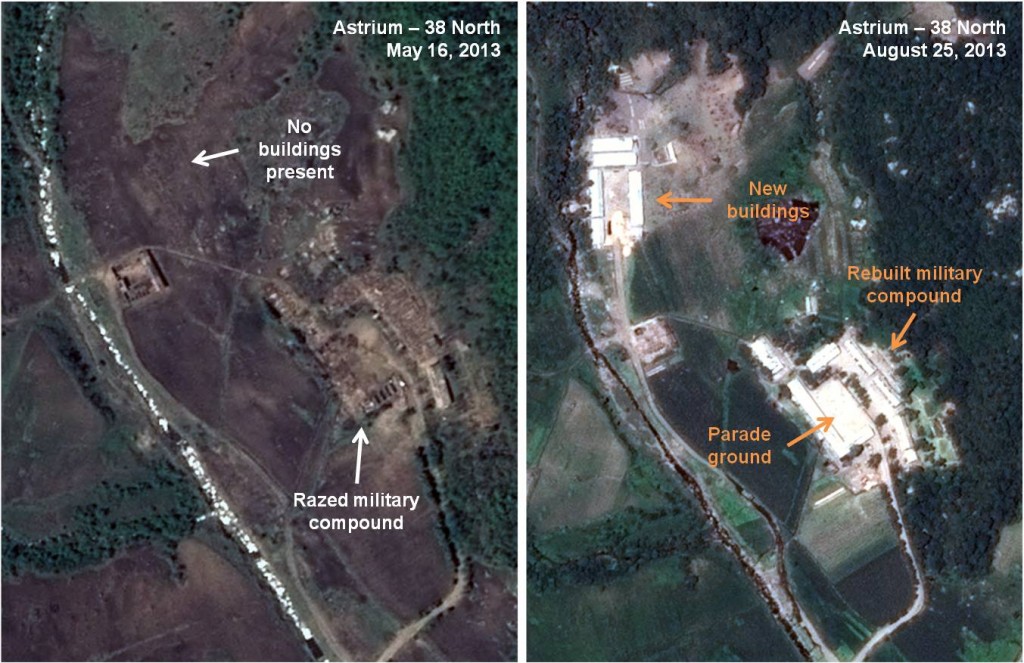
[1] North Korea launched mobile missiles from a circular flat pad in the 1980s and 1990s.
[2] For comparison, see imagery of the Sohae Satellite Launching station from May 16, 2013 at https://www.38north.org/2013/07/sohae071013/.
[3] While both these new missiles have been spotted in military parades in Pyongyang, neither appears to have ever been tested—although both appear based on proven technologies developed by the Soviet Union—leading some experts to speculate that they are fake. The construction of a flat pad for the conduct of mobile missile tests would indicate another step forward in the development process for these two weapons systems.
[4] North Korea suffers torrential rains each year. This year, North Pyongyan Province, in which Sohae is located, experienced severe flooding.
[5] The site is located on a ridge with good visibility down range to the launch pad 1.5 km to the south.
